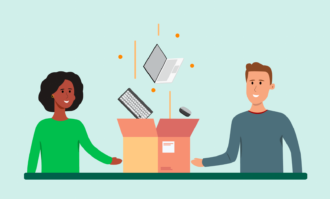Top onboarding survey questions
- Did the job description and the information conveyed in the interviews align?
- Were the materials thorough and easy to understand?
- Did you receive clear information regarding your initial tasks and priorities?
- Did the instructional resources suit your learning style?
- How do you feel new hires could be better supported?
- Do you have any uncertainties about the scope of your responsibilities?
- Have you discussed a career growth plan with your manager?
- Is there anything about our onboarding process that could be improved?
- Has your team connected with you via phone/Teams/Zoom/Slack during your first week?
Beginning a new job can be both exciting and stressful. A smooth onboarding process is important for easing a new hire into a company and getting them ready to work quickly. Companies invest considerable time and resources into new employee training, but even carefully designed onboarding programs sometimes lack one critical ingredient: feedback from their new hires.
In this article, we’ll discuss the importance of collecting feedback from new employees during the onboarding process. We’ll also provide a helpful list of onboarding survey questions that you can use during each stage of the new hire’s onboarding journey.
Whether you’re a human resources professional or a hiring manager, these questions can help refine your onboarding process, encourage engagement and productivity, and pave the way for your new hires’ success.
The purpose and benefits of onboarding surveys
An onboarding survey is a series of questions given to a new hire during or after their onboarding process. It’s a great way for HR professionals to gather information about new employees’ experiences.
These surveys can help companies quickly identify what’s working well in their training programs and what could be better. The right questions can provide insights that HR departments can use to improve onboarding programs for future hires.
Best onboarding survey questions for new hires
The onboarding process has a number of phases, and it’s important to capture feedback about these various intervals to make sure the entire process is effective and sets a new hire up for success.
Asking the right questions is important, but getting the timing of those questions right is also important. Some questions make more sense to ask near the beginning of an employee’s onboarding, in the middle of it, or at the end of it.
For example, it doesn’t make sense to ask a new hire about their future career development goals within your organization during their first week, as they’re just getting their bearings and familiarizing themselves with how you do things. It’s also not very helpful to ask whether a new hire had a productive first day once they’ve been working for several weeks.
To make the process of developing these surveys a little easier for you, we’ve made a list of 50 onboarding survey questions, organized by topic, with suggestions on when to ask them.
Recruitment
You can ask a new hire about the recruitment and hiring process soon after they join your company. Here are some questions that can help you gather valuable feedback about recruitment and hiring:
- Did the job description and the information conveyed in the interviews align?
- Was the interview timeline efficient? Was the interview process transparent?
- Did we convey the organization’s values and culture to you before you accepted an offer?
- Did we meet your expectations about the position and organization during the interview and recruitment process?
- Did we answer your questions and concerns to your satisfaction?
First day
A new hire’s first day on the job can be overwhelming. New employees meet their teams, get set up with company systems, and begin their introduction to their roles and responsibilities. First days are important for getting new hires off to a positive start. Once the dust has settled, but not too long after the first day, you can ask new employees these questions about it:
- Did we provide you with adequate information to prepare for your first day on the job?
- Were the materials thorough and easy to understand?
- Did you feel adequately prepared for your new role and excited for your first day?
- Were there any logistical difficulties or informational deficiencies you encountered prior to your first day?
- Did members of your team welcome you by email or phone before you started your first day?
- Was your workspace ready for you on your first day?
- Were technology resources ready for you on your first day?
- Were you comfortable asking for assistance if needed?
- Did your team introduce you to other coworkers?
- Did your experience on your first day meet your expectations?
First month
By now, your new hire has begun settling into their work routine. While they may still need to go through some training to be fully integrated into their team, you can still collect valuable information at this juncture. This period is also when a new hire begins to feel invested in a company’s culture and learns more about where they fit into the organization as a whole.
- Did you receive clear information regarding your initial tasks and priorities?
- Did you receive sufficient training to accomplish your first-month objectives?
- Did you receive constructive feedback on your first month’s contributions?
- What challenges or obstacles did you face during your first 30 days?
- Did your experience make you feel confident about your decision to join our organization?
Assessing training
After a new employee’s initial training is complete and they’ve had some time to settle into their role, it’s important to check with them about how well their training went and if they felt it adequately prepared them to do their job.
- Did the training materials you received equip you with the knowledge you needed to do your job?
- Were you given opportunities to apply what you learned during training to actual work situations?
- Did the instructional resources suit your learning style?
- Were you given assessments to measure your progress and performance?
- Were there any situations in which you felt you would have benefitted from additional training?
Gauging manager support
These questions focus on a new hire’s interactions with their supervisor. These questions can be especially useful for managers of larger teams who don’t always have the bandwidth to give personalized attention to every member of their team all the time.
- Has your manager given you the support and guidance you need to effectively start your role?
- Did your manager clearly convey your roles and responsibilities and your position within the team?
- Has your manager checked in with you regularly to discuss your progress and any concerns you may have? Has your manager made themselves available to answer questions?
- Has your manager delivered feedback constructively? Has this feedback helped in improving your performance?
- How do you feel new hires could be better supported?
Identifying gaps once the process is complete
It’s good to assess an employee’s entire onboarding process once they’ve fully settled into their new role. If you’ve surveyed your new hire throughout the onboarding process, you can compare their responses at the end of onboarding to those at the beginning to determine whether the employee’s confidence has grown from when you first hired them.
- Do you have a firm grasp of the objectives and expectations of your position?
- Do you have an understanding of how your role fits into the broader objectives of the organization?
- Do you have any uncertainties about the scope of your responsibilities?
- Have you been offered the proper support and access to resources you need to effectively perform your role?
- Are there any areas where you would like additional training?
Tracking career development plans
It’s important to proactively check in with employees, including new employees, about how they see their career paths with the company.
Surveying employees about their career development plans can help managers give team members guidance in their growth. They can assign responsibilities that are aligned with employees’ career goals and help them feel fulfilled in their jobs.
Surveys can also help identify internal candidates for open positions.
- Do you believe the organization is invested in your professional growth and development?
- Has management made you aware of possible career paths and promotion opportunities?
- Have you discussed a career growth plan with your manager?
- Has your manager given you the opportunity to take on additional responsibilities?
- Are there any additional skills you wish to acquire?
Assessing the onboarding experience overall
Once the new hire completes their onboarding, feels comfortable with their team, and establishes themselves in their role, you can solicit feedback about their experience on a more holistic level.
This is also a perfect opportunity to obtain quantifiable data with closed-ended questions, like rating scales. You can graph responses over time to identify trends and get a long-term view of employees’ views about your onboarding process.
- What stands out in your mind as a particularly positive aspect of the onboarding process?
- Is there anything about our onboarding process that could be improved?
- If you were talking to a new employee, what would you highlight about the onboarding process?
- On a scale of 1–10, with 1 being not ready at all and 10 being completely ready, how ready to tackle your job did you feel once the onboarding process was complete?
- On a scale of 1–10, with 1 being highly unlikely and 10 being very likely, how likely are you to refer someone to us based on your experience with our onboarding process?
Gathering feedback from remote employees
Today, it’s very normal for some or even all employees to work at their jobs remotely. Remote work poses unique challenges to the onboarding process, so it’s important to check in with new employees and make sure you’re providing enough support.
- Has our virtual onboarding process been helpful in acclimating you to our company’s culture?
- Have there been any challenges or obstacles with our remote onboarding process?
- Has your team connected with you via phone/Teams/Zoom/Slack during your first week?
- Do you feel able to easily communicate with your team using the available platforms?
- Do you have any suggestions for enhancing or improving the remote onboarding experience for future hires?
Tips for implementing effective employee onboarding surveys
Implementing an employee onboarding survey is about more than just compiling questions. Below are some steps that will help you properly plan and execute an effective employee onboarding survey.
Define goals and objectives
Identify the kind of information you want to gather from your new hires. For example, do you want to measure your employees’ satisfaction with the onboarding process, their retention of company policies and procedures, or their overall impression of company culture?
Your overall goals will determine the questions you use and your survey’s timing.
Select the right survey tool
Choosing the right tool to build your employee onboarding survey is especially important. A powerful, easy-to-use survey tool, like Jotform, can make the process seamless and quick. Jotform is a feature-rich survey-building platform that can meet all your employee onboarding survey needs.
You can easily build your survey from scratch with Jotform’s drag-and-drop Form Builder or choose from one of over 2,000 free, customizable survey templates, including templates specifically designed for employee surveys.
Jotform also gives you a variety of content and customization options. Choose from a range of question types and formats, such as multiple choice, rating scales, star ratings, dropdown selections, Likert scales, and more. Change your survey’s fonts, colors, and layout. You can also incorporate conditional logic into your survey, which allows you to show specific follow-up questions to respondents who select certain answers.
Use different types of survey questions
Design a series of questions that will help you gather the information you need. Be sure to include both open-ended and closed-ended questions to gather a wide variety of data. Quantitative data will help you observe trends, while qualitative data provides more personal feedback and can raise unique issues and ideas.
Choose an accessible distribution method
Decide how you’ll distribute the survey — you’ll want to use a format that’s easy and quick for your employees to access. Jotform surveys can be filled out from any device, and you have multiple sharing options — email, link, website embed, QR code, and even social media.
Schedule the survey based on your overall survey goals
You can schedule multiple short surveys throughout the new hire’s onboarding process, as discussed previously, or you could send a single, more comprehensive survey after onboarding is complete.
The timing really depends on what information you’re looking to gather. For example, hiring and first day questions should go out during an employee’s first week or soon after, while more comprehensive survey questions should be asked after onboarding is complete.
Review and analyze your submission data
Once you’ve compiled your survey responses, it’s important to carefully analyze the data to identify trends, patterns, and concerns. Jotform’s Report Builder automatically generates customizable visual reports based on survey submission data, simplifying this part of the process.
The process doesn’t end with the first survey, though. Regularly reviewing and analyzing survey submission data periodically lets you continually keep tabs on your onboarding process.
Communicate the results
Your carefully analyzed survey results can only make an impact when you share them with human resources and management stakeholders — people who have the decision-making power to improve onboarding.
Employee onboarding is a process with many moving parts. Below are some frequently asked questions about implementing onboarding surveys that can help make the process easier.
Frequently asked questions (FAQs)
No process is perfect right out of the gate. Processes need periodic refinement to correct deficiencies as well as to adjust to cultural and technological changes. Onboarding surveys provide companies with insights into what currently works and what could be improved, as well as what could be added that’s missing and what might need to be removed.
Depending on what information you want to gather with your survey, there are various points during the onboarding process at which you can survey new hires. As long as the survey is relatively brief and easy to complete, you can survey new employees after their first day or week, at the end of the first month, after their onboarding is complete, or at a combination of these times.
The first step to a strong future
Successful onboarding goes beyond simply preparing a new employee for their role. It’s also about setting them on a path for career growth and long-term contribution to your company.
By crafting thoughtful onboarding surveys and strategically timing when you deliver them to your new hires, you’ll set an onboarding path that encourages engagement and helps lead to a bright future for new hires in your organization.
Photo by Alexander Suhorucov

























Send Comment: